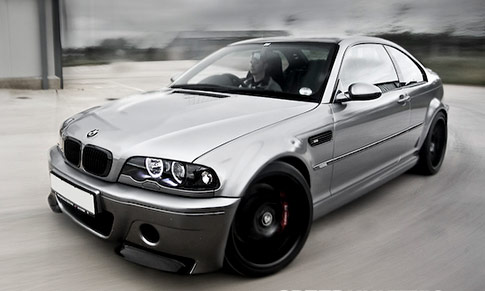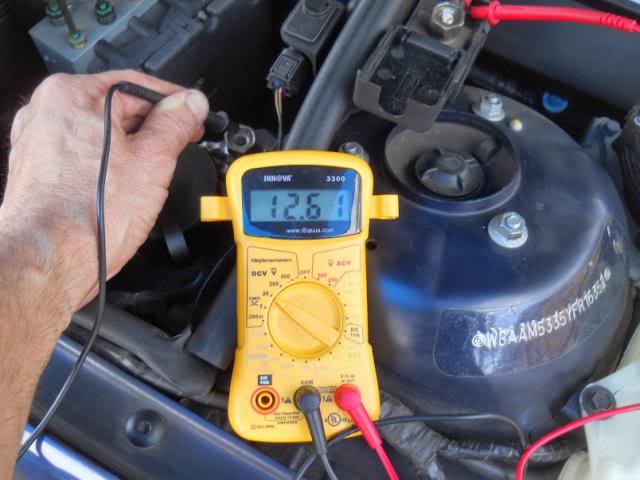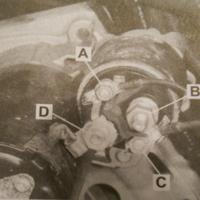What will do if you find your BMW E46 can not start?Maybe you will try to replace the battery,but there are many other trouble can cause engine can’t start.You will confused by them,and don’t know how to solved.For educational purpose,this article share all potential causes.Hope it is helpful!

1. Battery Trouble
A)Parasitic draw
If the engine runs fine when the battery is charged, or after a jump start, but the battery is dead by morning, there could be a short in the system draining the battery overnight. This is referred to as parasitic draw and on the E46 it is usually caused by a faulty final stage resistor (FSR) of the blower motor.Aftermarket equipment is another common source of parasitic draw.
B)Bad Connectons
If the battery and alternator are OK, but voltage is low at the starter, there could be a loose, or corroded connection in the electrical system, causing a voltage drop.Check the ground strap under the engine on the passenger side and the battery terminals.
The battery safety terminal (BST), located on the positive battery terminal, is designed to cut off power to the engine in case of an accident.If voltage is sufficient at the battery, but low at the underhood jumper terminals, there is a bad connection at the BST.

C)Bad Battery
If the starter isn’t cranking, or there is only a click, first check battery voltage with a digital multimeter, or using the OBC hidden functions.It needs to be at least 12V for the starter to be able to crank, while full battery voltage is close to 12.6V.
D)Faulty alternator
Te battery may have died because the alternator isn’t charging it.To test the alternator, first start the car by charging the battery, by jump start, or push start. Measure battery voltage with the engine running, it should be close to 14V, or slightly over.
2.Mechanical issues
A)No Compression
n engine needs spark, fuel and compression to run.If there is both spark and fuel and your car won’t start, test engine compression.
At times a condition called cylinder wash down occurs.If the engine started and run for a short time, or when an engine is cranked without starting,a lot of fuel is dumped into the cylinders. This can wash the oil off the cylinder walls and lead to loss of compression.Pour some oil in each cylinder, this will restore compression.
B) Camshaft timing
The timing chain assembly is reliable on the 6 cylinder engines, but can be problematic on the 4 cylinders models.
C)Engine seized
An internal mechanical failure can cause the engine to lock up.Try to turn the crankshaft manually to see if the engine is frozen.
D)Hydrolock
The crankshaft can not rotate due to liquid in the combustion chamber. This can be fuel, coolant, or oil, caused by a leaking fuel injector, headgasket, or a malfunctioning CCV system.Remove spark plugs and crank the engine if this is suspected.
E)Vacuum leak
Vacuum leaks usually cause rough running, or misfires, but a large vacuum leak can prevent starting.If your car won’t start after working around the intake, this is the most likely problem.In this case the engine may start up momentarily, but stalls immediately.
3.Switches and sensors
A) Ignition switch
If there is no power at terminal “C” on the starter with the key in the start position, there is either an EWS problem, or a bad ignition switch. A faulty ignition switch can cause either a no crank/no start, or crank/no start condition.Intermittent no start, or strange electrical symptoms are also typical signs of a failing ignitionWiggle the key as you start the car, that sometimes works if the switch is bad.
Crank/no start
Check battery voltage at fuse 29 while starting. This is the ignition switch input to the DME.Check battery voltage at pin 15 on the coil harness with the ignition on.Warning lights going off on the dash randomly, or suddenly while cranking is an indication of a faulty ignition switch.
No crank/no start
Check battery voltage on the black/blue wire at the ignition switch connector with the key in the start position.This wire supplies voltage to terminal “C” on the starter via the EWS module while starting.
No voltage in any of the tests indicates a defective switch.
B)Clutch switch
A defective clutch switch, (or not pressing the clutch pedal far enough) will prevent starting.
If battery voltage is OK and starter doesn’t crank, this is one of the possible issues.
To test the switch, bypass it by inserting a jumper wire in its connector. (wires violet/yellow and black/blue)Switch designs vary throughout the years.
C) Auto (neutral) safety switch
This is the equivalent of the clutch switch on an automatic, it allows the engine to start only in “P” and “N”.The gear selector switch, located on the side of the transmission performs this function.Move the shifter back and forth a few times before starting, this may enable start, if the switch is faulty.
D) Crank position sensor
The DME needs the signal from this sensor to fire the plugs.A faulty crank sensor usually throws a code, making diagnosis simple.If there is no code stored for this sensor, but no spark is suspected, check for spark.
E) Camshaft position sensor
A defective cam sensor most often results in driveability problems, like stalling, loss of power and rough running, but it can also prevent the engine from starting. This usually causes CEL, too.
4. Fuses, relays and modules
A) Immobilizer (EWS)
A faulty EWS module, a key that is not coded to the module, or damaged will prevent the engine from starting. There won’t be any power at terminal “C” on the starter solenoid, resulting in a no crank condition.
If you hear a beep with the key in the ignition and the driver’s door open, the EWS is recognizing the key. Trying to start the car with a second key is another simple way of ruling out a no start due to a non working key. A scan with a BMW specific scanner is necessary to detect EWS faults.
If your car is equipped with an additional aftermarket alarm system, make sure it is disarmed.
B) Fuses
E-box fuse pack: under the hood on the driver’s side where the DME and other electronic components are located, there is a fuse pack, containing 5 fuses. These are related to engine management. Fuse #3 sends power to both fuel pump relay and the crank sensor.
main fuse panel: check fuses 9, 22, 27, 29, 30 (ignition switch), 54 (fuel pump), and 14, 49, 67 (EWS). Inspect all fuses in the glove compartment if you’re dealing with a hard to diagnose no start problem.
high amp fuses above main fuse panel (fuseable links).
There is an 80 amp for the DME and DME main relay, and a 50 amp fuse for the ignition switch.
main harness fuse: behind the carpeting on the passenger side shock tower there is a large fuse.
The cable here supplies the relay panel, so if this fuse is blown, almost everything will be out.
C)DME main relay
Unlike the older models, this isn’t problematic on the E46. Test this relay if there is no battery voltage at the E-box fuses.
D)Electronic Control Unit (DME)
DME failure is also not common, but possible. A scan with a BMW specific scanner usually reveals if the unit is faulty.There may be no codes stored. If there is no spark, or injector signaland all DME inputs and wiring are OK, the DME needs replacing.
E) Fuel pump relay
No power at the fuel pump may be caused by a bad fuel pump relay.When checking for power at the pump, the engine needs to be cranked.A simple test for the fuel pump relay is to swap it with the horn relay, they are identical.Additional electrical tests can be done by jumpering terminals at the relay board.If the pump runs with the terminals jumpered, but not with the relay in place, the relay is defective.
5. Fuel related
A) Fuel pump.
If the starter is cranking, but the engine isn’t starting, the most likely issue is the fuel pump.There are a number of ways to verify:
– listen for the pump to prime when key is turned to position #2
– check for fuel at the fuel rail at the Schrader valve
– measure the actual fuel pressure (or lack thereof) at the rail
– spray starting fluid into the intake, if the engine stars briefly, fuel isn’t reaching the engine.
You can also remove the fuel pump cover and whack the pump, this may get it going temporarily.
This “method” can come in handy if you’re far away from home.
B) Engine is flooded
The M54 engines flood easily if they are started and run for a short time, like moving from one parking spot to another.If the engine won’t start shortly thereafter, the spark plugs might be saturated with fuel, preventing spark.
No start at a later time may be due to loss of compression. See Section 6. for more info on that.
C) No gas in tank
If the engine stalls, or will not start when the gas is under ¼ tank, the fuel pump is weak and should be replaced.The gas tank has two lobes and a weak pump isn’t able to transfer fuel from the other lobe.Fuel gauge maybe inaccurate, reading too high.
D) Bad gas
No start after the car was sitting for a long time.If your car runs rough and/or won’t start right after filling up with gas,the fuel might be contaminated.
E) Fuel filter
A clogged, or restricted fuel filter usually causes engine performance problems, but it can also contribute to no/hard start.
F) Fuel pressure regulator
On the 325i/330i this is part of the fuel filter, so by replacing the filter, the FPR will also be renewed. On the 323i/328i it’s separate from the filter. These rarely fail on the E46, but it’s a possibility. No start due to no, or low fuel pressure can be caused by a defective fuel pressure regulator.
6.Starter
If battery voltage is sufficient at the starter’s electrical connections and the starter is not cranking, it is most likely defective. Replacing the starter isn’t easy, so make sure the diagnosis is correct before you undertake this task.
Suggestions for troubleshooting:
Remove the airbox and the intake boots to gain access to the starter.
Measure voltage on two of the terminals on the starter solenoid.
Terminal “B” should have constant battery voltage.
Terminal “C” is energized by the ignition switch via EWS module when starting the engine.

Remove the wire from this terminal, measure voltage on the wire with the key in start position.
If sufficient battery voltage is present at both terminals and the starter isn’t cranking, it is defective.
You can also test the starter by jumpering, or “hot wiring” it.
This is done by applying direct voltage to some of the terminals.
When voltage is applied to terminal “D”, the starter motor should spin without cranking the engine.
When voltage is applied to terminal “C”, the starter should crank the engine.
Make sure you have good engine to chassis ground.
Sometimes there is a bad connection at the ground strap that is under the engine on the passenger side.
The starter can also get stuck. If voltage is sufficient, but the starter only clicks, this may be the case.
Tap the starter while a helper attempts to crank the engine. If it is stuck, this may get it going.
Make sure you have good engine to chassis ground.
Sometimes there is a bad connection at the ground strap that is under the engine on the passenger side.
The starter can also get stuck. If voltage is sufficient, but the starter only clicks, this may be the case.
Tap the starter while a helper attempts to crank the engine. If it is stuck, this may get it going.